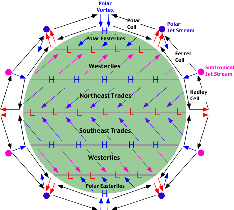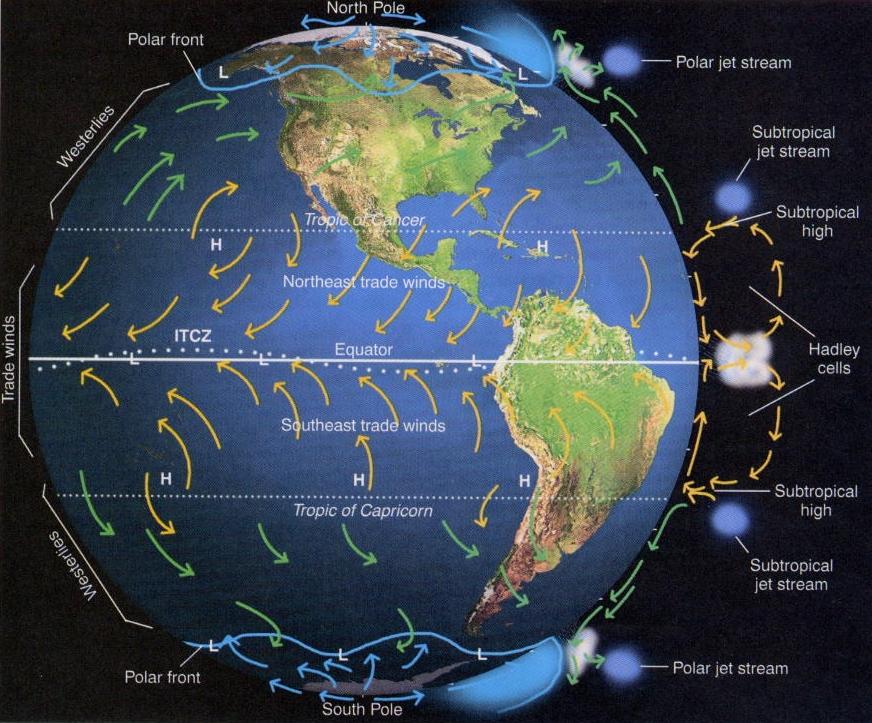 |
| Figure 1: Simplified one-cell global air circulation patterns. |
The first model will be founded on the following simplifying assumptions:
Based on these assumptions, air circulation on the Earth should approximate the patterns shown on the figure below. In this illustration, each hemisphere contains one three-dimensional circulation cell.
 |
| Figure 2: Simplified global three-cell surface and upper air circulation patterns. |
Planetary rotation would cause the development of three circulation cells in each hemisphere rather than one. These three circulation cells are known as the: Hadley cell; Ferrel cell; and Polar cell.
In the new model, the equator still remains the warmest location on the Earth. This area of greater heat acts as zone of thermal lows known as the Intertropical Convergence Zone (ITCZ).
The Intertropical Convergence Zone draws in surface air from the subtropics. When this subtropical air reaches the equator, it rises into the upper atmosphere because of convergence and convection. It attains a maximum vertical altitude of about 14 kilometers (top of the troposphere), and then begins flowing horizontally to the North and South Poles.
Coriolis force causes the deflection of this moving air in the upper atmosphere, and by about 30 degrees of latitude the air begins to flow zonally from west to east. This zonal flow is known as the subtropical jet stream.
 |
| Figure 3: |
The zonal flow also causes the accumulation of air in the upper atmosphere as it is no longer flowing meridionally. To compensate for this accumulation, some of the air in the upper atmosphere sinks back to the surface creating the subtropical high pressure zone.
From this zone, the surface air travels in two directions. A portion of the air moves back toward the equator completing the circulation system known as the Hadley cell. This moving air is also deflected by the Coriolis effect to create the Northeast Trades (right deflection) and Southeast Trades (left deflection).
The surface air moving towards the poles from the subtropical high zone is also deflected by Coriolis acceleration producing the Westerlies. Between the latitudes of 30 to 60 degrees North and South, upper air winds blow generally towards the poles.
Once again, Coriolis force deflects this wind to cause it to flow west to east forming the polar jet stream at roughly 60 degrees North and South.
On the Earth's surface at 60 degrees North and South latitude, the subtropical Westerlies collide with cold air traveling from the poles.
This collision results in frontal uplift and the creation of the subpolar lows or mid-latitude cyclones. A small portion of this lifted air is sent back into the Ferrel cell after it reaches the top of the troposphere. Most of this lifted air is directed to the polar vortex where it moves downward to create the polar high.
![[Positions of jet streams]](jets.gif)
|
| Positions of jet streams in the atmosphere. Arrows indicate directions of mean motions in a meridional plane. |
The general location of all three jet streams in relation to other mean meridional circulation features is shown above. Jet streams occur in both hemispheres. Those in the Southern Hemisphere resemble the northern hemispheric systems, though they exhibit less day-to-day variability due to the presence of smaller landmasses.
IAP weather web pages illustrate the general circulation of the atmosphere.